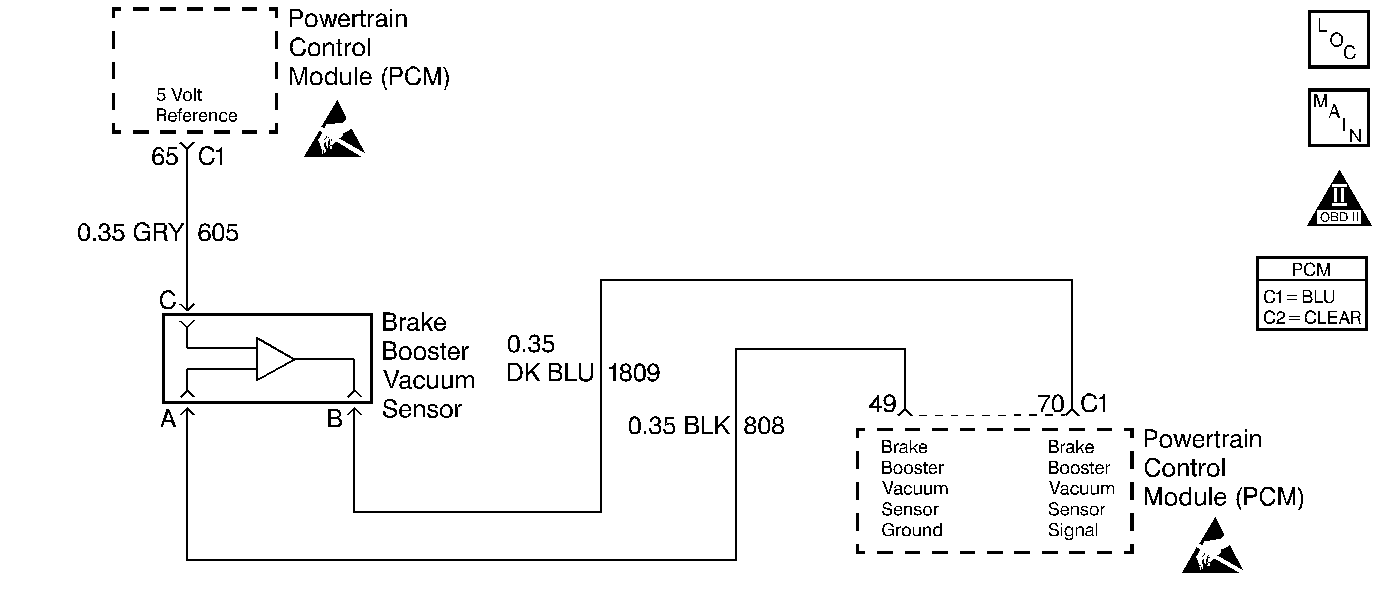
Circuit Description
The Brake Booster Vacuum (BBV) sensor changes resistance based on the vacuum inside the brake booster. This diagnostic test monitors the brake booster vacuum along with the manifold vacuum (calculated from MAP). If the brake booster vacuum is too low for a given manifold vacuum and the brakes are not applied, then the brake booster vacuum signal must be in error and DTC P1578 is set.
Conditions for Setting the DTC
Test Conditions
| • | DTCs P0107, P0108, P1106, P1577, and P1602 not set. |
| • | Engine speed 500 RPM or greater for 20 seconds. |
| • | Brakes not applied. |
| • | Barometric pressure 72 kPa or greater. |
| • | MAP 60 kPa or less. |
Failure Condition
Brake booster vacuum 5 kPa or less for 16 seconds.
Action Taken When the DTC Sets
| • | The Malfunction Indicator Lamp (MIL) will not illuminate. |
| • | The PCM will command a message to be displayed. |
| • | The PCM may record operating conditions at the time the diagnostic fails. This information will be stored in the Failure Records. |
Conditions for Clearing the Message/DTC
| • | The PCM will turn the message OFF after one run and pass of the diagnostic test. |
| • | A History DTC will clear after forty consecutive warm-up cycles with no failures of any non-emission related diagnostic test. |
| • | A Last Test Failed (current) DTC will clear when the diagnostic runs and does not fail. |
| • | Use a scan tool to clear DTCs. |
| • | Interrupting PCM battery voltage may or may not clear DTCs. This practice is not recommended. Refer to Clearing Diagnostic Trouble Codes in PCM Description and Operation. |
Diagnostic Aids
Manipulate the wire harness while watching the scan tool display looking for opens and shorts.
Reviewing the Failure Rec. may help diagnose an intermittent failure by showing how long ago and under what conditions the DTC set.
Test Description
Number(s) below refer to the step number(s) on the Diagnostic Table.
-
If the brake booster vacuum signal is too low, display will be 5 kPa or less. If it is not, then the signal is not too low and an intermittent problem must be present.
-
Checking for vacuum leaks that are causing the low signal.
-
With the BBV sensor terminals B and C jumpered together, brake booster vacuum should read greater than 81 kPa. If it does not, a wiring problem must be present.
Step | Action | Value(s) | Yes | No |
|---|---|---|---|---|
1 | Was the Powertrain On-Board Diagnostic (OBD) System Check performed? | -- | Go to A Powertrain On Board Diagnostic (OBD) System Check | |
Is the display the same or less than the value specified? | 5 kPa | Fault not present. Refer to Diagnostic Aids | ||
With engine idling, check vacuum to brake booster with vacuum gage. Is vacuum greater than the value specified? | 14 Hg. (47 kPa) | |||
Is the display the same or less than the value specified? | 81 kPa | |||
5 | Using DMM J 39200 measure voltage to ground on jumper. Is voltage less than the value specified? | 0.5 volts | ||
6 |
Is voltage the same or more than the value specified? | 4.5 volts | ||
7 |
Is the resistance the same or less than the value specified? | 5 ohms | ||
8 | Repair the open or high resistance in CKT 1809. Is the repair complete? | -- | Go to Powertrain Control Module Diagnosis for Verify Repair | -- |
9 | Repair short to ground in CKT 1809. Is the repair complete? | -- | Go to Powertrain Control Module Diagnosis for Verify Repair | -- |
10 | Repair open or short to ground in CKT 605. Is the repair complete? | -- | Go to Powertrain Control Module Diagnosis for Verify Repair | -- |
11 |
Was terminal contact repaired? | -- | Go to Powertrain Control Module Diagnosis for Verify Repair | |
12 | Replace the BBV sensor. Is the replacement complete? | -- | Go to Powertrain Control Module Diagnosis for Verify Repair | -- |
13 |
Was terminal contact repaired? | -- | Go to Powertrain Control Module Diagnosis for Verify Repair | |
14 | Replace the PCM. Refer to PCM Replacement/Programming . Is the replacement complete? | -- | Go to Powertrain Control Module Diagnosis for Verify Repair | -- |
15 | Locate and repair cause of low vacuum at brake booster. Has the repair been performed? | -- | Go to Powertrain Control Module Diagnosis for Verify Repair | -- |
